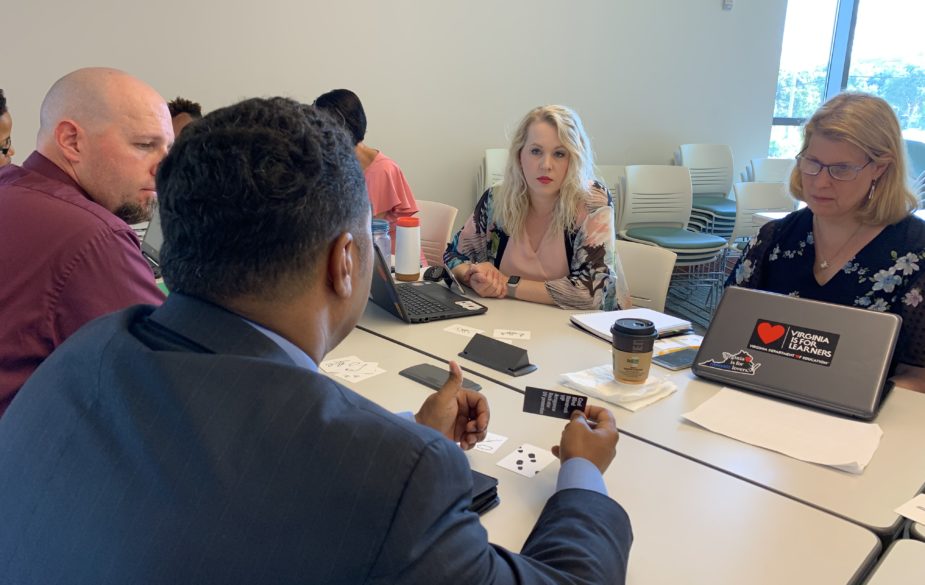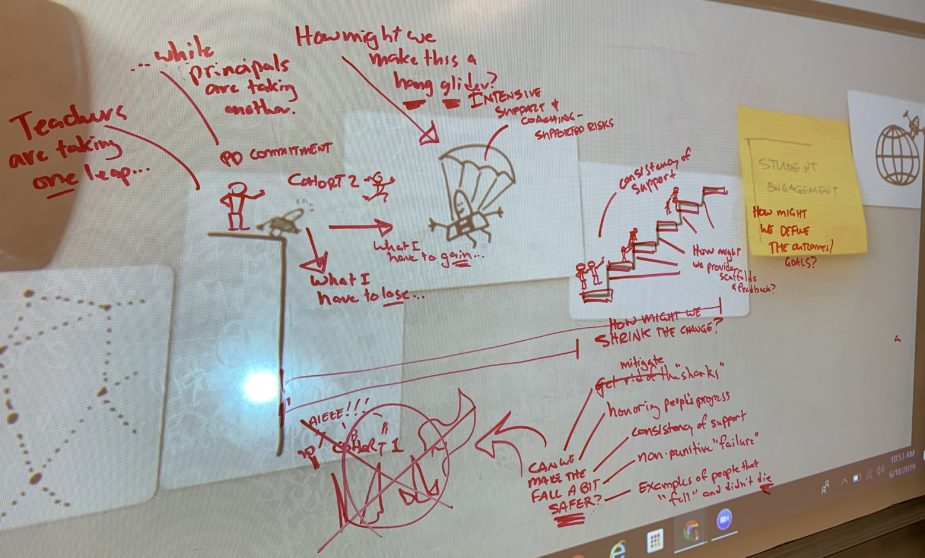Innovation. Transformation. Change.
These words have definitive meaning, and yet are often so hard to define. Such is the experience of many teams who find themselves getting caught up in the meaning of the words themselves when seeking to gain a clearer understanding of that which they are trying to describe. In these moments, making thinking more visual in nature can be a game changer for unblocking a team’s common language.
For instance, a look at the eight cards chosen from the deck of Think Clearly Strategy Cards below. What ideas do they conjure? What story might they tell?

These cards and a few more ended up in the hands of a collection of members of the #VAis4Learners Innovation Network (#VaLIN) during a convening of the regional cohort this summer. We started the design session together by using the cards dealt to the team to describe the current state of their innovation team’s work to date.
In the example of the team of leaders from Suffolk City Public Schools, what followed was not an explanation of their current state, but instead a story that invited continuation. Their summary of the story they crafted through the exercise:

Road Map To Innovation
We have spent the last few months focusing our steps on the pathways to innovative engagement for all levels and stakeholders. We have identified the areas of fear for teachers and administrators and are working to help all stakeholders recognize the best strategies and practices to prepare global citizens.
Digging deeper, each element of their visual outline held a specific purpose in their story of current state. Exploring the element of fear of change, for example, they have noted that many of their educators may see the span of the chasm between current and ideal state as too far a leap to make successfully, while others may see falling into the depth of the canyon below as being too painful a risk to take.
These fears have become the new driver of their pathway to innovation. As such, their team’s goals emerged as twofold:
- To create a bridge that helps to span that gap by creating resources that help bring common understanding around practices that promote engagement.
- To provide “protective” resources (represented by the parachute) that allow for a safer trip across the shortened span. These resources could include the support of coaches, high-quality planning resources, and targeted professional learning opportunities.
All that shared understanding, brought about in five goofy cards.
In the same vein, a participant from Goochland County shared the context of their district’s work:
Jump Start Innovation!
School might be out, but we continue to create opportunities for teachers to learn innovative practice from each other through our summer symposium event. Teachers have shared great practices that engage student learners such as mindfulness, scaffolding practice with coding, and ways that we influence the environment.
In addition, the division continues to work on vertical opportunities and experiences through performance assessments that carry real world and authentic themes through our students’ learning. Teams are considering a real-world or authentic theme that flows from a K-12 experience. Example cross-disciplinary themes include Economics, Human and Environmental Impact, and others. Exposure to real-world themes will follow students across their school experience, helping them make sense of the content they have been charged with learning.

Petersburg City team members (the gracious hosts of our event) offered a musical theme to their summary:
Creating a Masterpiece
Much like an orchestra, the members of Petersburg City Public Schools and our local partners have been composing various pieces of a synchronous plan to meet the unique needs of our student population. We need to create our own sheet of music inspired from others yet unique to our own tune.
The pieces are coming together in a coordinated fashion in an effort to address the whole child in their journey from elementary to secondary, with STEM, Arts, Coding, Career and Tech Education, wrap-around services; to college, career and beyond. In part driven by insights gained from our spring site visits in Powhatan and Goochland, ideas have been emerging around how we utilize our STEAM labs toward opportunities for all of our classrooms to engage toward these learning target outcomes. Additionally, we have introduced the challenge of development of Big Hairy Audacious Goals (BHAGs) with regard to the teaching and assessing the SOLs to inspire a different way of teaching and learning for our teams.
Lessons Learned from Making Thinking Visual
Engaging in exercises like this one taps into our natural desire to make meaning. I have facilitated this exercise (or one like it) dozens of times. Each time, participants find the meaning they seek, no matter the cards they hold. The teams engaging during this session were no exception: each referenced that it seemed as if they had been dealt “the perfect cards” to describe their current state.
Getting the team’s thinking “on the table” helps accelerate toward taking action. Throughout the afternoon, each team spent their time moving forward on the steps they identified as opposed to getting mired in “the weeds” of what they had not yet defined. Their collaborations with other members of the regional cohort have led to previously untapped approaches to shaping these innovations, and they are now on a path to creating the variety of resources and offerings that they might collect, create, or curate so as to provide teachers with what they need to take the leap.
Words are sometimes contextual, while visuals can be universal (and therefore transferable). Suffolk City captured and shared a snapshot of their thinking in a tweet, one that came to the aid of another team 24 hours and 278 miles later. As a team in the School District of Philadelphia (SDP) began to unpack how to inspire educators toward technology integration that engages students more as producers than as consumers, the Suffolk team’s thinking offered a starting place that helped them better understand the challenge they faced.

The SDP team’s collaboration offered newfound insights into the challenge, its underlying causes, and its potential solutions, which we captured in the form of How Might We questions to drive their next steps:
- How might we clearly define what success looks like?
- How might we shrink the change between where people are and the other side of the chasm?
- How might we provide scaffolds that promote action through feedback?
- How might we make the parachute into a hang glider?
- How might we make the pull of what there is to gain stronger than the fear of what they have to lose?
- How might we make the fall safer?
- How might we mitigate the negative impact of landing?
- How might we honor the act of “jumping, falling, and climbing back up” as progress and not failure?
- How might we share examples of those that may have “fallen” but did not get injured?
- How might we more clearly understand the similarities and differences between the chasm facing our teachers and that facing our principals?
As an added benefit, these questions also inspired new thinking in the Suffolk City team when this “remixed” artifact was shared back with them. These new insights are likely to spur on even more effective action for both teams. One team member wrote:
I like the variation from the Philly team’s process. Several of the questions jumped out to me that I think will help us tackle our next steps. I am really drawn to the question: How might we shrink the change? and how that directly relates to non-punitive failure. In some cases, we face issues with teacher and principal buy-in, and that idea of the size of the change being one of those reasons why. Finding solutions to that area of weakness will be huge factors in our success.
I am now thinking about our decision to focus solely on one or two content areas, but also perhaps opening it up to others. That way, those who are ready to take the risk have that option to do so. Interesting new ideas…
In the end, this post is not a story of past lessons learned, but rather a continued co-authorship of a future we are in the midst of creating together. How might this collection of visible (and visual) thinking inspire the authorship of your own future? How might these questions posed by these two teams inform new steps forward? And how might your share your remixes and revisions such that others may learn with you?
We look forward to seeing the products of your thinking. Once you have made them visible, feel free to capture and share them on twitter with the hashtag #ALPlearn. We’ll be on the lookout.

